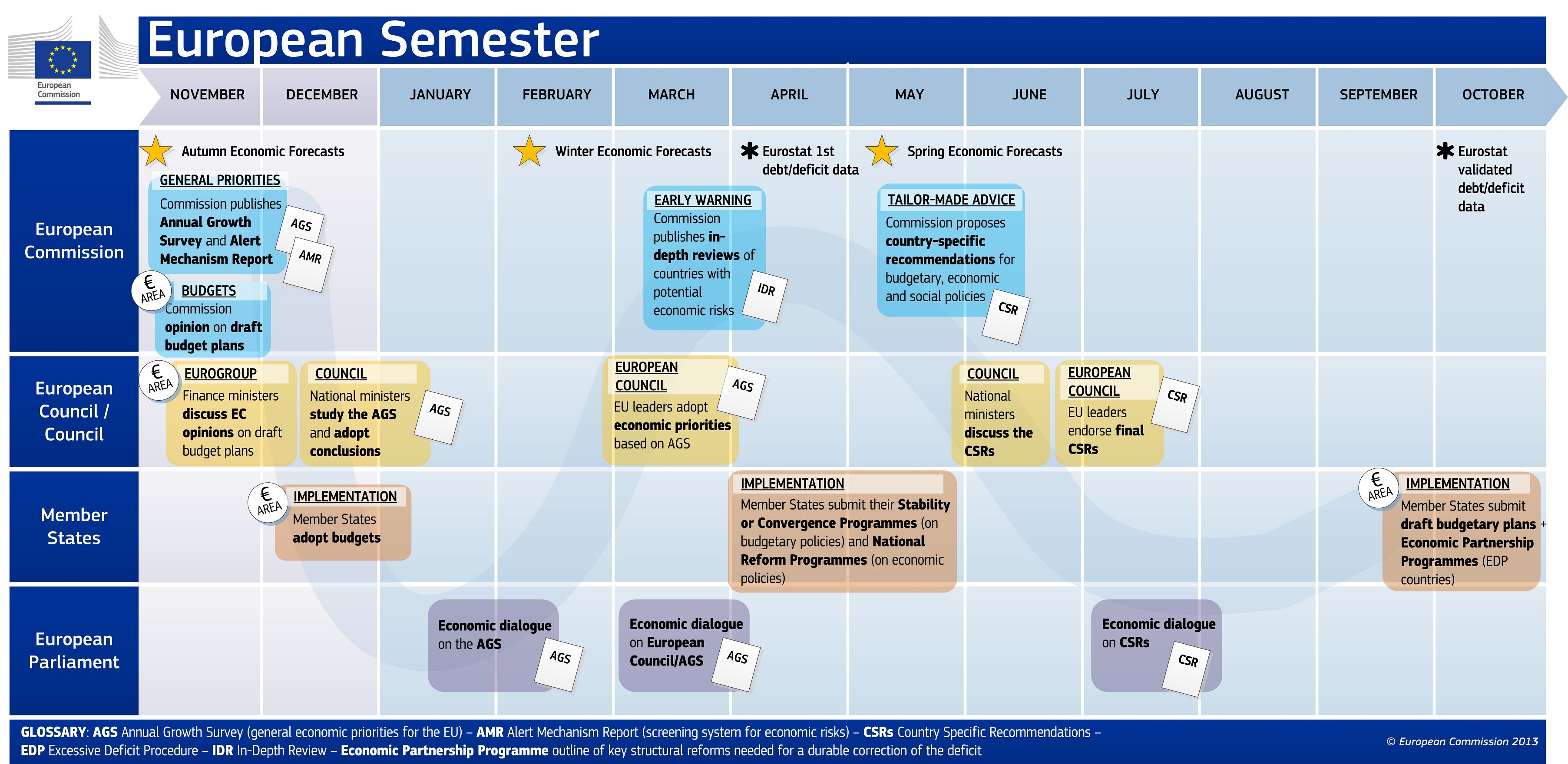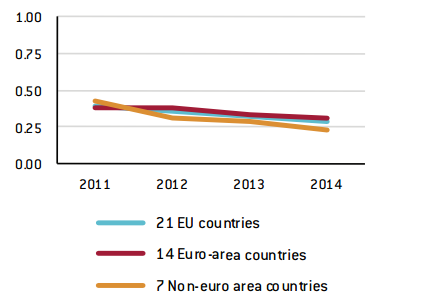
The European economic Semester explained
Economy 7 December 2015On the 21st of October 2015 the Collegium of European Commissioners agreed on the proposed package of measures aimed at deepening the European Monetary Union (EMU). One of the four key goals predicted by the Package, was a revamped European Semester.
The European Semester is an economical instrument of the Union striving to consolidate the economic and fiscal stability and discipline both within the Eurozone and the Member States of the Union. In its basic structure, it consists of three parts which are equally distributed through the fiscal year: the Autumn economic forecast, starting each November, the Winter economic forecast, starting in February, and the Spring economic forecast, starting in May.
In accordance to the definition of the European Commission, the European Semester is an annual cycle of “economic policy guidance and surveillance“. Bearing in mind the very developed and complex economic policy within the Union, it is not a big issue for this entity to provide the “economic guidance” for its Member States. It has already been done through various instruments. What is surprising, in its definition, is that the financial part of the instrument, which is with high intense inherited to its implementation, is not mentioned. However, even the word “surveillance” raises some problems. Who does the EU monitor? How does it do that? Are there any other alternatives to those instruments? Are they efficient in practice?
Making it possible
The European Semester begins around November each year with the publication of two key economic reports: the Annual Growth Survey and the Alert Mechanism Report. Afterwards, in March, the EU leaders meet in order to review the AGS and the AMR and develop the common direction of fiscal and structural policies, in general. Also, the Commission makes a specific single-country reports, with numerous recommendations in economic and financial areas, respectively based on the agreed policies. In addition, every November is set for the Commission to express its opinion on draft budget plans of the Eurozone Member States. It is important to understand that the Commission is able to do so only for the countries that have accepted Euro as their official currency. This is one of the rare situations where the Commission’s jurisdiction is limited only to the Eurozone Member States, not only in the economic but the general area(s) as well.
The Winter part of the Semester that approximately occurs during February (with an extension to March), is the next step in which Member States report to the Commission on the achieved results and on what are the planned reforms to implement, in accordance with the previous specific report(s). Also, at the European Council level, Prime Ministers and/or Presidents of the Member States adopt economic priorities based on Annual Growth Survey (AGS), which has been published before.
The EU’s Member States then implement those priorities and recommendations during the Spring part of the Semester (April and/or May). It is of high importance for the instrument to respect timing and commitments during the fiscal year. Even though the Semester does not match with the fiscal and calendar year in general, it has its own dynamics, as shown on the photo below.
An individually-holistic approach and its actors
Despite the fact that this instrument has been created in order to monitor and guide the Member States of the European Union, it also was established to keep and preserve the economic and fiscal stability across Member States of the Union.
It is difficult to define in which level it prevails, but there can be for sure several point of views. On the one hand, there is a national level in terms of budgetary monitoring process and fiscal stability within a single state; on the other, there is the existing efforts in unifying the European economic system in general.
The European Semester would not be sustainable without the main stakeholders, which partially coordinate action(s) in order to achieve its fundamental goals. Those are the European Commission, European Council (and the Council of Ministers), Member states and the Parliament. Though, the EU Commission have the biggest role within this instrument, other institutional structures are partially involved within the process. At the end, there is a one more actor included in this process: the Eurozone group, given the fact that most of the decisions and recommendations are made exclusively for the Eurozone Member States.
The main limitations
There is a one key issue concerning the limitations of the European Semester. It is probably the only economic instrument, which regulates fiscal commitments and budgetary dynamics throughout the Union, at supra-national level. This claim could not be really justified, since there are some OECD recommendations for all its Member States.
Also, limitations are related to the shape of the passive protest of the EU Member States which are not willing to respect the rules of the instrument. Some states (especially the UK, Denmark, Sweden and all other non-eurozone states) deny to commit their obligations under the common aquis communitaire. This could bring new potential problems not only to the Eurozone, but to the Union as a whole.
Scientific researches show very pessimistic views on the topic. In the first line, they announce the possible break of the system. Their analyses show that the main limitation of the system is actually a “non-discipline” of the EU Member States. According to the results of their researches, there is a very low reforms implementing index.
It varies from less than a half of percent down to 0.25, which means that the highest recommendations fulfilment and the implementation of the key public reforms among the EU Member States is extremely low. In the case of the best ranked states, it practically means that the concrete state achieved only one half of the total number of recommendations came from the instrument.
The bunch of national economies or a disciplined single economic entity?
The European Semester was enacted in 2011 with the consent of the Council and the European Parliament to foster economic policy coordination, to enforce the overhauled Stability and Growth Pact and the new macroeconomic imbalance rules, and to achieve Europe 2020 targets.
When analysing the European economic Semester, we should be careful, since these kinds of instruments are very tough to explore and to predict their effects in the future. Hence, the main question to be answered should be whether the Semester is introduced in order to foster or to monitor the European economy in general.
What makes the situation more complex is the paradoxical situation, in which the European Semester becomes the European “Trimester”, since there is one more time element within the instrument, which makes the third element of it. This is the Spring part of the Semester, which has not been introduced in the first version of the instrument in 2011.
These issues are associated to the distinction between the original idea on which it is based on. Some officials claim that it is aimed at unifying the European single national economies, while the academic community states that, oppositely, it is aimed at disciplining a single European economic entity, creating a tough-functioning system without the clear perspective.









